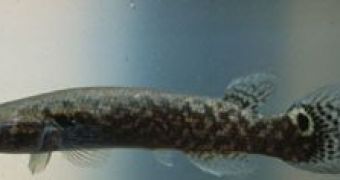By definition, a fish lives in water. Some may burrow during the dry season, breathing - through lungs, intestine membrane, labyrinths or other specialized organs - oxygen from the air, but they have an active life in the water. Mudskippers, relatives of the gobies, cope well with life on the wet mud of the mangroves.
But mangroves have now come with something that challenges the classic 'definition' of fish: a species that lives in trees! Scientists in Belize and Florida have found that the mangrove killifish (Kryptolebias marmoratus) of the western Atlantic, a tiny species weighing 0.1 g, inhabits trees when the water they usually live in is gone.
Hundreds of killifish were taking refuge in the rotting logs and branches of mangrove trees during drought conditions, lined up like beans in a pod inside the galleries made by insects. While installing in the trees, fish decrease their normal territorial aggression so that hundreds of individuals live side-by-side.
This fish normally lives in ephemeral pools around the roots of the mangrove trees and was already known to withstand for months in moist spots on land.
"The logs could be one of the reasons why the killifish occupies such a large range from southern Brazil to central Florida. They might be washed ashore in a rotting log and start a new population," said John Avise, an evolutionary biologist at the University of California at Irvine
The life in the trees lowers the possibilities of finding a mate, but the fish is able to reproduce on its own, since it is hermaphrodite, and the only known hermaphrodite vertebrate able of self-fertilization (the sperm produce by one individual fertilizes its own eggs). "The fish -- which normally live in mangrove swamps -- are able to change their bodies and metabolism to cope with life out of water. The changes are reversed as soon as they return to the water. They really don't meet standard behavioral criteria for fish", Scott Taylor of the Brevard County Environmentally Endangered Lands Program in Florida told New Scientist.
Amongst the adaptations are reshaping of the gills to retain water and food and the synthesis of extra skin proteins that help excreting nitrogen waste. Many killifish are popular aquarium species. Guppy is perhaps the most famous.

 14 DAY TRIAL //
14 DAY TRIAL //